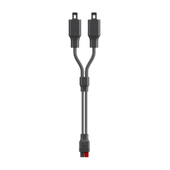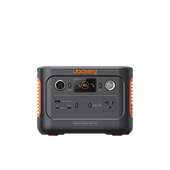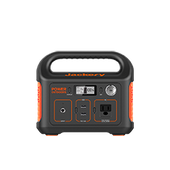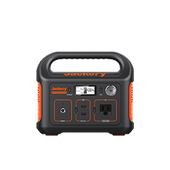When it comes to purchasing batteries, most of the time, we do not pay much attention to battery ratings. However, it's one of the most critical factors you must consider beyond the battery's size, ability, and purpose. While you might know the difference between AA, AAA, and D cells, only a few people can differentiate their performance and purpose. For example, if you want to charge home or outdoor appliances, a portable power station with around 1500-3000Wh would suffice.
Jackery provides a wide range of compact power stations like Jackery Explorer 1000 Plus, Jackery Explorer 2000 v2, Jackery Explorer 2000 Plus, and Jackery Explorer 3000 Pro. All of these portable power stations have reasonable wattage and can charge most of your electrical appliances.
What is Battery Rating?
A battery is a source of electricity consisting of one or more electrochemical cells to power electrical devices. The battery rating defines the average amount of current the battery releases over a particular time under normal use. In other words, a battery with a rating of 200 Ah can typically deliver 20 amps of power for 10 hours at a constant rate.
At the most basic level, a battery is something that stores energy for later use. Most batteries are generally made of lead-acid type, but the new and more advanced batteries are manufactured using NMC or LiFePO4. The battery rating approximates the battery's charge capacity or how much power it can store and helps you choose the right power station for your needs.
What Are The Types of Battery Ratings?
Generally, batteries with a high volume of electrolytes and highly active electrodes have high battery ratings compared to the smaller batteries with inactive electrodes. Here are two main types of battery ratings.
C-Rating: A battery C rating measures the current in which a battery is charged or discharged. Generally, the battery capacity is rated and labeled at the 1C Rate (1C current).
Ah Rating: Amp-hour or Ah is the unit that measures the battery's energy capacity and tells how much current a battery can provide at a certain rate and for a specific period.
The charge and discharge rates of any battery are generally controlled by battery C rates. Here's a table that reveals the different battery C ratings and how long they take to charge or discharge.
|
C-Rate |
Time |
|
5C |
12 min |
|
2C |
30 min |
|
1C |
1H |
|
0.5C or C/2 |
2H |
|
0.2C or C/5 |
5H |
|
0.1C or C/10 |
10H |
|
0.05C or C/20 |
20H |
Battery capacity, also known as battery Ah rating, represents the battery capability. While many Ah ratings are available, the most common ones include 50Ah, 100Ah, and 200Ah. The amp hour of the battery indicates how much charge it can store or deliver.
How to Calculate C Rating on A Battery?
LiFePO4 (or Lithium iron phosphate) is a rechargeable battery technology with high safety, improved efficiency, and a longer lifespan. They have high power density and can charge most electrical appliances. But what is the C rating on a LiPO battery? The typical C rating of a LiFePO4 battery is 1C, and the maximum C rate can cross 3C for a LiFePO4 prismatic battery.
The simple formula to calculate the battery C rating is as follows:
C-rate © = Charge or discharge current (in amps) / Rated battery capacity (in Ah)
If the battery has a rated capacity of 100Ah and a charge or discharge current of 100A, the C rating will be 100A/100Ah = 1C.
Alternatively, if you are calculating the battery Ah rating, the formula will be:
Amp hour = Current (I) * Discharge Time (T)
If the current is 30A and the discharge time is 0.5 hours, the amp-hours will be 30A*0.5 = 15Ah.
Jackery Explorer Power Stations have varied battery capacities, making them ideal for charging various appliances. For example, the Jackery Explorer 3000 Pro has a high battery capacity of 3024Wh and an amp-hour rating of 70Ah, making it an excellent choice for charging 99% of home or outdoor appliances.
Jackery Portable Power Stations with Higher Battery Ratings
Jackery is one of the leading brands that manufactures solar generators, solar panels, and power stations. The Jackery SolarSaga Solar Panels have monocrystalline silicon solar cells that capture the sun's rays and then convert them to electricity. This electric energy is stored in the Jackery Explorer Portable Power Station, where the pure sine wave inverter converts the DC current into usable AC electricity. With the generated power, you can charge the home or outdoor appliances for long hours.
Here are the popular and larger-capacity Jackery Explorer Power Stations available.
Jackery Explorer 3000 Pro Portable Power Station
The Jackery Explorer 3000 Pro has a 3024Wh battery capacity and can charge 99% of appliances. It has a suitcase design, all thanks to the pull rods and double wheels. With the help of 6*Jackery SolarSaga 200W Solar Panels, you can charge the portable power station in only 3-4 hours. One unique aspect of the battery is its ability to power RVs and travel trailers.
"Used this during my last camping trip, and it is awesome! Powered my microwave, portable fridge/freezer, 2 heated blankets at night and still have plenty of battery left the next day." — Chris.
Jackery Explorer 2000 Plus Portable Power Station
The Jackery Explorer 2000 Plus is an expandable power station with a battery capacity of 2042.8Wh. It's also compatible with the additional Jackery Battery Pack 2000 Plus, so you can expand the capacity from 2kWh to 24kWh. Furthermore, it's pretty easy to recharge: just connect the 6*Jackery SolarSaga 200W Solar Panels with the Jackery Explorer 2000 Plus to charge the power station in only 2 hours.
"After researching several top brands in the "2000" size, the Jackery Explorer 2000 Plus was a no-brainer. What a piece of mind in the time of need to know you can double, triple, QUADRUPLE the stored power available." — Greg Bond
Jackery Explorer 2000 v2 Portable Power Station
The Jackery Explorer 2000 v2 Portable Power Station is ideal for outdoor adventures, providing reliable power to most of your appliances. Whether you're camping, RVing, or hosting an outdoor gathering, it can run essentials like portable fridges, cooking gear, and lights, ensuring comfort and convenience. It can also help you power essential devices like cameras, GPS units, and drones to capture and navigate your journey. With the foldable handle and compact design, it's your go-to power station for seamless outdoor fun.
Customer Review
"We ended up getting the 2000W model and just tried it out with our camper, including using the microwave, and it works great. It is not something we intend to use for regular power, but it will also work great, recharging our E-bikes when away from the camper or in dry camping situations. Overall a great addition to our equipment." — Stephen Merritt.
Jackery Explorer 1000 Plus Portable Power Station
The Jackery Explorer 1000 Plus Portable Power Station is a lifesaver during brief power outages, offering enough capacity to keep essential devices and appliances running. It can power lights, fans, and other small to midsize electronics to maintain normalcy until the grid is restored. The compact and easy-to-use design provides peace of mind in emergencies. It is also expandable and supports add-on battery packs to extend the capacity from 1.2kWh to 5kWh for extended power outages.
Customer Review
"This is my second Jackery. Have the explorer 250 and love it. Bought this for my new 12v fridge/ car camping rig. So far this thing packs some power. Ran the fridge for 28 hours using like 14% which is wild. Saga panels are easy to set up and store. Also worth noting the customer service is fantastic." — Christian Cassidy.
|
|
Explorer 2000 v2 |
Explorer 1000 Plus |
||
|
Working Hours |
Refrigerator (520W): 4.5H TV (60W): 29.1H Heater (1800W): 1.3H Microwave (1000W): 2.4H Electric Grill (900W): 2.6H Coffee Maker (1000W): 2.4H Electric Oven (800W): 3.0H |
Refrigerator (520W): 3.0H TV (60W): 19.7H Heater (1800W): 55 min Microwave (1000W): 1.6H Electric Grill (900W): 1.8H Coffee Maker (1000W): 1.6H Electric Oven (800W): 2.0H |
Refrigerator (520W): 3.1H TV (60W): 21.7H Heater (1800W): 55 min Microwave (1000W): 1.6H Electric Grill (900W): 1.8H Coffee Maker (1000W): 1.6H Electric Oven (800W): 2.0H |
Refrigerator (520W): 1.9H TV (60W): 13.4H Microwave (1000W): 1.0H Electric Grill (900W): 1.1H Coffee Maker (1000W): 1.0H Electric Oven (800W): 1.2H |
Note: The running time of the power stations calculated in the table is just for reference and based on mathematical formulas. However, the actual working hours might vary.
How to Find Battery Rating? How to Choose Battery Via Battery Rating?
Typically, small batteries have a 1C rating and are called a one-hour rate. For instance, a 3000mAh battery at a one-hour rate has a 1C rating of 3000mAh. This is generally available on the battery label or the battery data sheet.
Lead-acid batteries have a low discharge rate of around 0.05C or 20-hour Rate. On the other hand, lithium-ion batteries have a much higher discharging C rate. The following chart reveals the battery C rating of LiFePO4 vs. lead acid.
 There's no doubt that a powerful battery can act as an alternative power source when the electricity grid fails. When choosing the correct battery, you must consider multiple factors like lifespan, weight, usable capacity, and safety considerations.
There's no doubt that a powerful battery can act as an alternative power source when the electricity grid fails. When choosing the correct battery, you must consider multiple factors like lifespan, weight, usable capacity, and safety considerations.Capacity: The battery capacity is one of the most critical factors that reveals how much energy it can store or supply to the appliances. The higher the battery capacity, the longer the battery can charge electrical appliances.
Weight: If you use the battery to charge outdoor appliances, ensure it has a low weight. For example, the larger Jackery Explorer Power Stations come with a lightweight nature, foldable handle, and even wheels for easy carrying.
Safety: LiFePO4 and lithium-ion batteries are safer compared to the alternative solutions available in the market. Thanks to the built-in safety mechanism, they can charge the appliances safely.
Lifespan: The battery's lifespan means the number of charging and discharging cycles it can undergo without harming its performance.
Battery Rating FAQs
How do you measure battery rating?
The battery rating is based on capacity and measured in amp-hours (or Ah). Similarly, the rated battery capacity defines the average amount of current it can release over a certain period under normal usage.
What is the standard battery rating?
The standard battery is rated and labeled at 1C Rate (1C current). However, the exact battery rating will depend on the type of the battery. For example, car batteries usually have 40-65Ah, whereas typical automotive batteries are 70Ah at 3.5A.
What is the battery SAE rating?
The SAE (or Society of Automotive Engineers) sets the battery's minimum charge and discharge characteristics. With the SAE test, you can check the battery's starting ability and high-rate capacity capability.
Is a higher Ah battery better?
A battery with a higher Ah value typically lasts longer than a lower Ah battery. For example, a 70Ah battery will supply power for longer hours than a 35Ah battery. A higher Ah battery might be your best bet if you want to charge devices like drones or power tools that need a longer runtime.
Do higher Ah batteries give more power?
A higher Ah battery does not mean it is more powerful. On the contrary, it means a battery with a high Ah value will have more runtime than a low Ah battery. In addition, higher Ah batteries can store more energy, helping them charge appliances for long hours.
Final Thoughts
With the help of battery rating, you can understand which power station can safely charge the appliances. Jackery Explorer Power Stations have different Ah and Wh ratings — and can power most of your home or outdoor appliances. While the Jackery Explorer 1000 Plus has an Ah rating of 30.4Ah, the Jackery Explorer 3000 Pro has 70Ah.
If you want a powerful and expandable portable power station, the Jackery Explorer 2000 Plus makes more sense. It has a large battery capacity of nearly 2042.8Wh and can be expanded to 24kWh with an additional Jackery Battery Pack 2000 Plus. It's an excellent choice for someone looking for high power for indoor and outdoor purposes.




















































































































Leave a comment